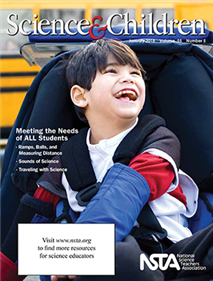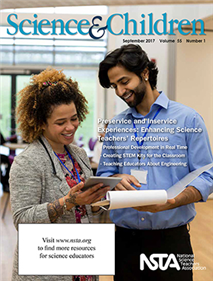All Physics resources
Journal Article
Second graders turn knowledge into action as they engineer solutions for a real-world problem in a school makerspace....
Journal Article
Formative Assessment Probes: Uncovering “Maker” Ideas About Sound
This column focuses on promoting learning through assessment. This issue discusses the Making Sound probe....
Journal Article
Science 101: Why Do Helicopters Always Have Two Blades, and How Does That Help Cats?
This column provides background science information for elementary teachers. This issue discusses torque....
Blog Post
How Teachers Are Retooling Lessons Using the EQuIP Rubric
Sometimes finding the right book or article can be the key to opening our minds to new ideas. A few years back, NSTA published a special journal series on the NGSS, and I recently re-read a few of them. Three in particular highlighted teachers’ exp...
By
NSTA Press Book
Beyond the Egg Drop: Infusing Engineering Into High School Physics
Problem: You’re eager to expand your physics curriculum and engage your students with engineering content but you don’t know how. Solution: Use the approach and lessons in Beyond the Egg Drop to infuse engineering into what you’re already teach...
By Arthur Eisenkraft, Shu-Yee Chen Freake
Journal Article
Science 101: Why Do Computers Keep Getting Smaller and Smaller?
This column provides background science information for elementary teachers. This month’s issue discusses the history of why computers have reduced in size....
Blog Post
The Engineering Design Process: A Middle School Approach
To support the Next Generation Science Standards (NGSS) Middle School Engineering Design, we have three goals for our students: to define problems accurately, design the best solution using a rigorous process, and evaluate and improve their designs b...
By Cindy Workosky
Journal Article
Science 101: Can Electromagnetic Waves Affect Emotions?
This column provides background science information for elementary teachers. This month’s issue discusses electromagnetic waves....
Blog Post
When I began aligning my instruction to the Next Generation Science Standards (NGSS), I got lost in the details. But when I realized that phenomena could be used to anchor linked disciplinary core ideas, I started to visualize the course as a whole a...
By Cindy Workosky
Blog Post
Using the Crosscutting Concepts to Scaffold Student Thinking
At the recent NSTA National Conference in Los Angeles, three-dimensional learning was, of course, a major topic of discussion. When those discussions focus on classroom instruction, though, the crosscutting concepts are often the forgotten dimension....
By Cindy Workosky





